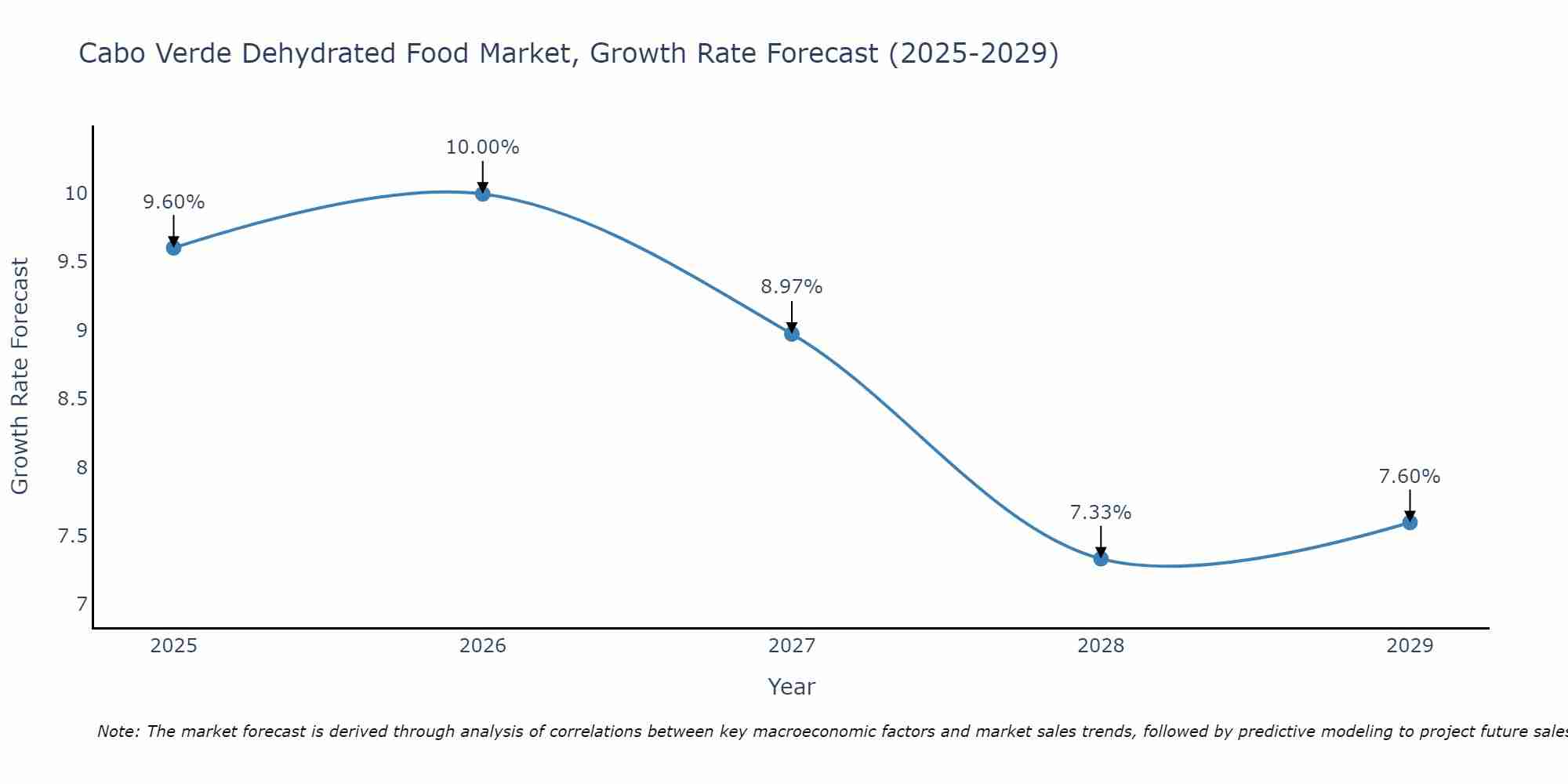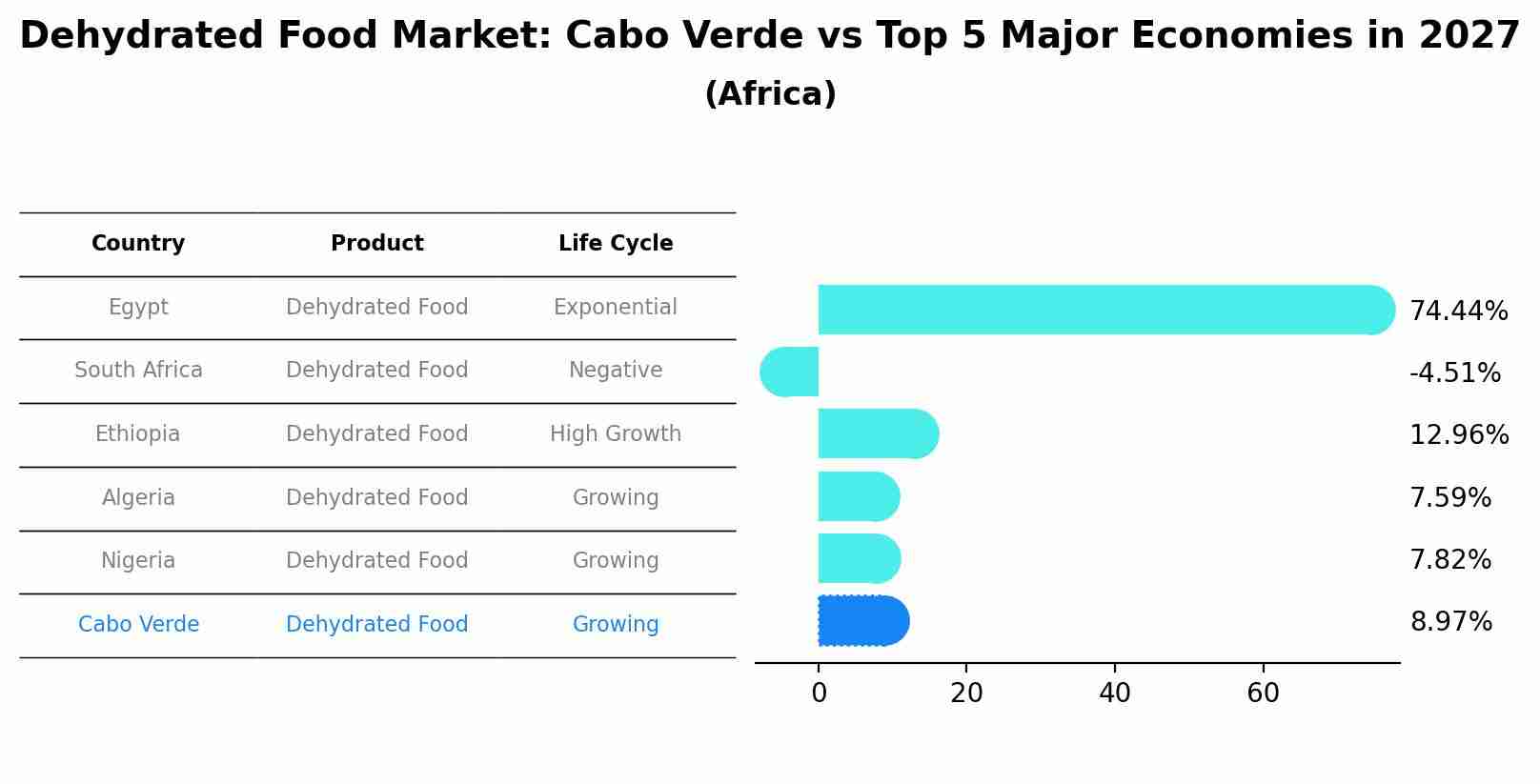Cape Verde Dehydrated Food Market (2025-2031) | Segmentation, Size, Growth, Revenue, Trends, Industry, Share, Companies, Outlook, Analysis, Value & Forecast
| Product Code: ETC4837226 | Publication Date: Nov 2023 | Updated Date: Apr 2025 | Product Type: Market Research Report | |
| Publisher: 6Wresearch | Author: Sachin Kumar Rai | No. of Pages: 60 | No. of Figures: 30 | No. of Tables: 5 |
Cabo Verde Dehydrated Food Market Size Growth Rate
The Cabo Verde Dehydrated Food Market is projected to witness mixed growth rate patterns during 2025 to 2029. Starting at 9.60% in 2025, the market peaks at 10.00% in 2026, and settles at 7.60% by 2029.

Dehydrated Food Market: Cabo Verde vs Top 5 Major Economies in 2027 (Africa)
Cabo Verde's Dehydrated Food market is anticipated to experience a growing growth rate of 8.97% by 2027, reflecting trends observed in the largest economy Egypt, followed by South Africa, Ethiopia, Algeria and Nigeria.

Cape Verde Dehydrated Food Market Overview
The Cape Verde dehydrated food market is expanding as a result of rising demand for long-shelf-life food products and the growing popularity of convenience foods. Dehydrated foods offer the advantages of extended storage without refrigeration and reduced weight, making them ideal for both domestic use and export. Factors such as changing dietary preferences, urbanization, and the need for emergency food supplies contribute to the market`s growth.
Drivers of the market
The Cape Verde Dehydrated Food market is driven by the need for long-lasting, easy-to-store food products due to the country`s geographic isolation and limited local production. Dehydrated foods offer a convenient solution to ensure food security and reduce wastage. The growing urban population and increasing preference for ready-to-eat meals also fuel the demand for dehydrated food products.
Challenges of the market
The dehydrated food market in Cape Verde encounters issues related to supply chain inefficiencies and high transportation costs, which impact the overall pricing and availability of products. Limited local production capacity for raw materials further exacerbates these challenges. Moreover, consumer awareness and acceptance of dehydrated foods are relatively low, which can hinder market growth.
Government Policy of the market
Government policies impacting the dehydrated food market in Cape Verde focus on food security and agricultural development. Policies may include incentives for local production, regulations on food safety, and support for importers of dehydrated food products. Additionally, there could be initiatives to promote sustainable agricultural practices and investments in food processing infrastructure.
Key Highlights of the Report:
- Cape Verde Dehydrated Food Market Outlook
- Market Size of Cape Verde Dehydrated Food Market, 2024
- Forecast of Cape Verde Dehydrated Food Market, 2031
- Historical Data and Forecast of Cape Verde Dehydrated Food Revenues & Volume for the Period 2021-2031
- Cape Verde Dehydrated Food Market Trend Evolution
- Cape Verde Dehydrated Food Market Drivers and Challenges
- Cape Verde Dehydrated Food Price Trends
- Cape Verde Dehydrated Food Porter`s Five Forces
- Cape Verde Dehydrated Food Industry Life Cycle
- Historical Data and Forecast of Cape Verde Dehydrated Food Market Revenues & Volume By Type for the Period 2021-2031
- Historical Data and Forecast of Cape Verde Dehydrated Food Market Revenues & Volume By Spray-dried for the Period 2021-2031
- Historical Data and Forecast of Cape Verde Dehydrated Food Market Revenues & Volume By Freeze-dried for the Period 2021-2031
- Historical Data and Forecast of Cape Verde Dehydrated Food Market Revenues & Volume By Vacuum-dried for the Period 2021-2031
- Historical Data and Forecast of Cape Verde Dehydrated Food Market Revenues & Volume By Drum-dried for the Period 2021-2031
- Historical Data and Forecast of Cape Verde Dehydrated Food Market Revenues & Volume By Others for the Period 2021-2031
- Historical Data and Forecast of Cape Verde Dehydrated Food Market Revenues & Volume By Product for the Period 2021-2031
- Historical Data and Forecast of Cape Verde Dehydrated Food Market Revenues & Volume By Dried Processed Food for the Period 2021-2031
- Historical Data and Forecast of Cape Verde Dehydrated Food Market Revenues & Volume By Dried Fruit & Vegetable for the Period 2021-2031
- Historical Data and Forecast of Cape Verde Dehydrated Food Market Revenues & Volume By Dried Dairy for the Period 2021-2031
- Historical Data and Forecast of Cape Verde Dehydrated Food Market Revenues & Volume By Dried Meat & Seafood for the Period 2021-2031
- Historical Data and Forecast of Cape Verde Dehydrated Food Market Revenues & Volume By Others for the Period 2021-2031
- Historical Data and Forecast of Cape Verde Dehydrated Food Market Revenues & Volume By Distribution Channel for the Period 2021-2031
- Historical Data and Forecast of Cape Verde Dehydrated Food Market Revenues & Volume By Hypermarket/Supermarket for the Period 2021-2031
- Historical Data and Forecast of Cape Verde Dehydrated Food Market Revenues & Volume By Convenience Stores for the Period 2021-2031
- Historical Data and Forecast of Cape Verde Dehydrated Food Market Revenues & Volume By Online Retailing for the Period 2021-2031
- Historical Data and Forecast of Cape Verde Dehydrated Food Market Revenues & Volume By Others for the Period 2021-2031
- Cape Verde Dehydrated Food Import Export Trade Statistics
- Market Opportunity Assessment By Type
- Market Opportunity Assessment By Product
- Market Opportunity Assessment By Distribution Channel
- Cape Verde Dehydrated Food Top Companies Market Share
- Cape Verde Dehydrated Food Competitive Benchmarking By Technical and Operational Parameters
- Cape Verde Dehydrated Food Company Profiles
- Cape Verde Dehydrated Food Key Strategic Recommendations
Frequently Asked Questions About the Market Study (FAQs):
1 Executive Summary |
2 Introduction |
2.1 Key Highlights of the Report |
2.2 Report Description |
2.3 Market Scope & Segmentation |
2.4 Research Methodology |
2.5 Assumptions |
3 Cape Verde Dehydrated Food Market Overview |
3.1 Cape Verde Country Macro Economic Indicators |
3.2 Cape Verde Dehydrated Food Market Revenues & Volume, 2021 & 2031F |
3.3 Cape Verde Dehydrated Food Market - Industry Life Cycle |
3.4 Cape Verde Dehydrated Food Market - Porter's Five Forces |
3.5 Cape Verde Dehydrated Food Market Revenues & Volume Share, By Type, 2021 & 2031F |
3.6 Cape Verde Dehydrated Food Market Revenues & Volume Share, By Product, 2021 & 2031F |
3.7 Cape Verde Dehydrated Food Market Revenues & Volume Share, By Distribution Channel, 2021 & 2031F |
4 Cape Verde Dehydrated Food Market Dynamics |
4.1 Impact Analysis |
4.2 Market Drivers |
4.3 Market Restraints |
5 Cape Verde Dehydrated Food Market Trends |
6 Cape Verde Dehydrated Food Market Segmentations |
6.1 Cape Verde Dehydrated Food Market, By Type |
6.1.1 Overview and Analysis |
6.1.2 Cape Verde Dehydrated Food Market Revenues & Volume, By Spray-dried, 2021-2031F |
6.1.3 Cape Verde Dehydrated Food Market Revenues & Volume, By Freeze-dried, 2021-2031F |
6.1.4 Cape Verde Dehydrated Food Market Revenues & Volume, By Vacuum-dried, 2021-2031F |
6.1.5 Cape Verde Dehydrated Food Market Revenues & Volume, By Drum-dried, 2021-2031F |
6.1.6 Cape Verde Dehydrated Food Market Revenues & Volume, By Others, 2021-2031F |
6.2 Cape Verde Dehydrated Food Market, By Product |
6.2.1 Overview and Analysis |
6.2.2 Cape Verde Dehydrated Food Market Revenues & Volume, By Dried Processed Food, 2021-2031F | 6.2.3 Cape Verde Dehydrated Food Market Revenues & Volume, By Dried Fruit & Vegetable, 2021-2031F |
6.2.4 Cape Verde Dehydrated Food Market Revenues & Volume, By Dried Dairy, 2021-2031F |
6.2.5 Cape Verde Dehydrated Food Market Revenues & Volume, By Dried Meat & Seafood, 2021-2031F |
6.2.6 Cape Verde Dehydrated Food Market Revenues & Volume, By Others, 2021-2031F |
6.3 Cape Verde Dehydrated Food Market, By Distribution Channel |
6.3.1 Overview and Analysis |
6.3.2 Cape Verde Dehydrated Food Market Revenues & Volume, By Hypermarket/Supermarket, 2021-2031F |
6.3.3 Cape Verde Dehydrated Food Market Revenues & Volume, By Convenience Stores, 2021-2031F |
6.3.4 Cape Verde Dehydrated Food Market Revenues & Volume, By Online Retailing, 2021-2031F |
6.3.5 Cape Verde Dehydrated Food Market Revenues & Volume, By Others, 2021-2031F |
7 Cape Verde Dehydrated Food Market Import-Export Trade Statistics |
7.1 Cape Verde Dehydrated Food Market Export to Major Countries |
7.2 Cape Verde Dehydrated Food Market Imports from Major Countries |
8 Cape Verde Dehydrated Food Market Key Performance Indicators |
9 Cape Verde Dehydrated Food Market - Opportunity Assessment |
9.1 Cape Verde Dehydrated Food Market Opportunity Assessment, By Type, 2021 & 2031F |
9.2 Cape Verde Dehydrated Food Market Opportunity Assessment, By Product, 2021 & 2031F |
9.3 Cape Verde Dehydrated Food Market Opportunity Assessment, By Distribution Channel, 2021 & 2031F |
10 Cape Verde Dehydrated Food Market - Competitive Landscape |
10.1 Cape Verde Dehydrated Food Market Revenue Share, By Companies, 2024 |
10.2 Cape Verde Dehydrated Food Market Competitive Benchmarking, By Operating and Technical Parameters |
11 Company Profiles |
12 Recommendations | 13 Disclaimer |
- Single User License$ 1,995
- Department License$ 2,400
- Site License$ 3,120
- Global License$ 3,795
Search
Related Reports
- Portugal Electronic Document Management Market (2025-2031) | Strategy, Consumer Insights, Analysis, Investment Trends, Opportunities, Growth, Size, Share, Industry, Revenue, Segments, Value, Segmentation, Supply, Forecast, Restraints, Outlook, Competition, Drivers, Trends, Demand, Pricing Analysis, Competitive, Strategic Insights, Companies, Challenges
- France Electronic Document Management Market (2025-2031) | Strategy, Consumer Insights, Analysis, Investment Trends, Opportunities, Growth, Size, Share, Industry, Revenue, Segments, Value, Segmentation, Supply, Forecast, Restraints, Outlook, Competition, Drivers, Trends, Demand, Pricing Analysis, Competitive, Strategic Insights, Companies, Challenges
- Portugal Occupational Health & Safety Services Market (2025-2031) | Strategy, Consumer Insights, Analysis, Investment Trends, Opportunities, Growth, Size, Share, Industry, Revenue, Segments, Value, Segmentation, Supply, Forecast, Restraints, Outlook, Competition, Drivers, Trends, Demand, Pricing Analysis, Competitive, Strategic Insights, Companies, Challenges
- Netherlands Occupational Health and Safety Services Market (2025-2031) | Strategy, Consumer Insights, Analysis, Investment Trends, Opportunities, Growth, Size, Share, Industry, Revenue, Segments, Value, Segmentation, Supply, Forecast, Restraints, Outlook, Competition, Drivers, Trends, Demand, Pricing Analysis, Competitive, Strategic Insights, Companies, Challenges
- Belgium and Luxembourg Facility Management Market (2025-2031) | Strategy, Consumer Insights, Analysis, Investment Trends, Opportunities, Growth, Size, Share, Industry, Revenue, Segments, Value, Segmentation, Supply, Forecast, Restraints, Outlook, Competition, Drivers, Trends, Demand, Pricing Analysis, Competitive, Strategic Insights, Companies, Challenges
- Russia Women Intimate Apparel Market (2025-2031) | Strategy, Consumer Insights, Analysis, Investment Trends, Opportunities, Growth, Size, Share, Industry, Revenue, Segments, Value, Segmentation, Supply, Forecast, Restraints, Outlook, Competition, Drivers, Trends, Demand, Pricing Analysis, Competitive, Strategic Insights, Companies, Challenges
- Africa Chocolate Market (2025-2031) | Size, Share, Trends, Growth, Revenue, Analysis, Forecast, industry & Outlook
- Global Hydroxychloroquine And Chloroquine Market (2025-2031) | Industry, Trends, Size, Outlook, Growth, Value, Companies, Revenue, Analysis, Share, Forecast
- Saudi Arabia Plant Maintenance Market (2025-2031) | Industry, Size, Growth, Revenue, Value, Companies, Forecast, Analysis, Share & Trends
- Taiwan Electric Truck Market (2025-2031) | Outlook, Industry, Revenue, Size, Forecast, Growth, Analysis, Share, Companies, Value & Trends
Industry Events and Analyst Meet
Our Clients
Whitepaper
- Middle East & Africa Commercial Security Market Click here to view more.
- Middle East & Africa Fire Safety Systems & Equipment Market Click here to view more.
- GCC Drone Market Click here to view more.
- Middle East Lighting Fixture Market Click here to view more.
- GCC Physical & Perimeter Security Market Click here to view more.
6WResearch In News
- Doha a strategic location for EV manufacturing hub: IPA Qatar
- Demand for luxury TVs surging in the GCC, says Samsung
- Empowering Growth: The Thriving Journey of Bangladesh’s Cable Industry
- Demand for luxury TVs surging in the GCC, says Samsung
- Video call with a traditional healer? Once unthinkable, it’s now common in South Africa
- Intelligent Buildings To Smooth GCC’s Path To Net Zero













